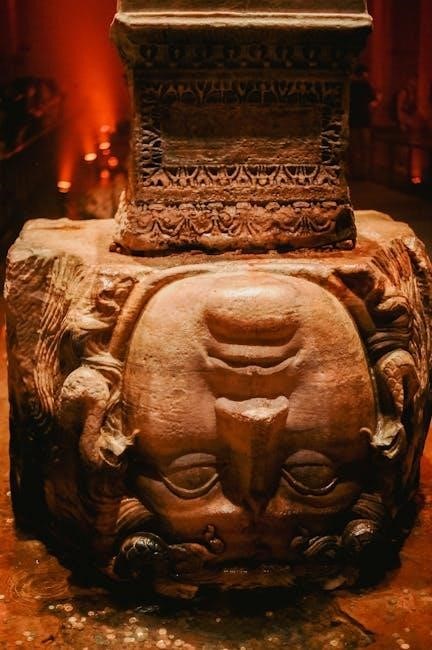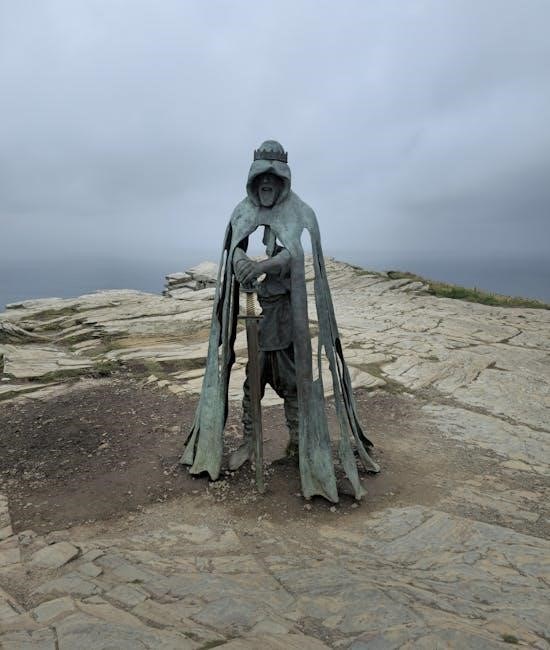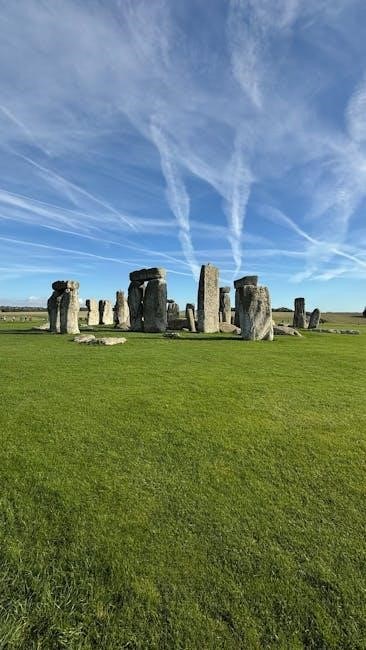Karen Armstrong: A Short History of Myth ⎯ Overview
Karen Armstrong’s “A Short History of Myth” provides a concise exploration of myth’s evolution. From ancient origins to modern relevance, Armstrong examines the purpose and transformations of myth. The book analyzes humanity’s storytelling and beliefs, offering insightful perspectives on its cultural impact.
Key Themes Explored in “A Short History of Myth”
“A Short History of Myth” delves into several key themes surrounding the nature, function, and evolution of myth throughout human history. Armstrong explores the origins of myth in early human societies, linking it to Neanderthal burial practices and the dawn of civilization. The book examines how myths provided early explanations for the world and humanity’s place within it.
The Axial Age, a pivotal period in spiritual and philosophical development, is another central theme. Armstrong analyzes how this era transformed mythological thinking, leading to new ethical and philosophical frameworks. The interplay between myth and science is also a recurring theme, exploring their historical relationship and how they address fundamental human questions. Armstrong analyzes the Greek myth of Perseus and Medusa as emblematic of this relationship.
Furthermore, the book traces the evolution of myth as a reflection of humanity’s changing understanding of itself and the universe. Armstrong delves into the purpose of myth, arguing that it serves vital psychological, social, and spiritual functions. These themes collectively contribute to a comprehensive understanding of myth’s enduring significance.
Myth’s Origins: From Neanderthal Practices to Early Civilizations
Karen Armstrong’s “A Short History of Myth” traces the roots of myth back to the earliest human behaviors, starting with Neanderthal burial practices. These practices, which suggest a belief in an afterlife or a spiritual dimension, represent a nascent form of symbolic thought and storytelling. Armstrong proposes that these early rituals laid the groundwork for the development of more complex mythological systems.
As human societies evolved, so did their myths. Early civilizations, such as those in Mesopotamia and Egypt, developed elaborate mythologies that explained the origins of the world, the nature of the gods, and the purpose of human existence. These myths were not merely stories; they were integral to the social, political, and religious structures of these societies. Myths provided a framework for understanding the world and a guide for how to live within it.
Armstrong highlights how these early myths often reflected the agricultural cycles and the natural environment, embedding practical knowledge and moral lessons within their narratives. This exploration of myth’s origins underscores its fundamental role in shaping early human cultures and worldviews.

The Axial Age: A Turning Point in Mythological Development
In “A Short History of Myth,” Karen Armstrong identifies the Axial Age (roughly 8th to 3rd centuries BCE) as a pivotal period in the evolution of mythological thought. This era witnessed the emergence of new philosophical and religious ideas across various cultures, from Greece to India to China, fundamentally altering how humans understood their place in the cosmos.
Armstrong argues that the Axial Age marked a shift from mythologies focused on ritual and sacrifice to those emphasizing ethics, compassion, and self-awareness. Thinkers like Confucius, Buddha, and the Greek philosophers questioned traditional beliefs and sought deeper meaning in human existence. This led to the development of new ethical frameworks and spiritual practices that transcended local customs and addressed universal human concerns.
The Axial Age myths and philosophies emphasized personal responsibility and the importance of living a virtuous life. This transformation laid the groundwork for the major world religions that continue to shape human societies today. Armstrong emphasizes that this period’s intellectual ferment represents a crucial turning point in humanity’s understanding of itself and its relationship to the divine.
Myth and Science: Interplay and Relationship
Karen Armstrong, in “A Short History of Myth,” explores the complex relationship between myth and science, arguing that they serve distinct but complementary functions in human understanding. She posits that myth is not simply primitive science, but rather a way of grappling with existential questions that science cannot address. While science seeks to explain the empirical world, myth provides meaning, purpose, and a framework for ethical behavior.
Armstrong highlights that throughout history, myth and science have often coexisted. Ancient civilizations used myths to explain natural phenomena before scientific explanations were available. However, even as scientific knowledge advanced, myths continued to provide a sense of belonging and connection to something larger than oneself. The Greek myth of Perseus and Medusa exemplifies this interplay, reflecting cultural anxieties and values alongside emerging scientific thought.
Armstrong emphasizes that the conflict between myth and science arises when they are mistaken for each other. Science should not attempt to answer questions of meaning, and myth should not be taken as literal fact. Instead, both should be recognized for their unique contributions to human knowledge and experience. Understanding this distinction is crucial for navigating the complexities of the modern world.

The Evolution of Myth: A Reflection of Humanity’s Journey
In “A Short History of Myth,” Karen Armstrong meticulously traces the evolution of myth as a mirror reflecting humanity’s ever-changing journey. From the Neanderthal burial practices, suggesting early symbolic thought, to the sophisticated narratives of ancient civilizations, myth has adapted to reflect the anxieties, aspirations, and understanding of each era.
Armstrong emphasizes that myths are not static; they are dynamic and responsive to cultural shifts. As societies evolved, so did their myths, incorporating new knowledge, values, and social structures. The Axial Age, for example, marked a profound transformation in mythological development, with the emergence of new ethical and philosophical systems that challenged traditional beliefs.
The evolution of myth also reflects humanity’s ongoing quest for meaning and purpose. Myths provide frameworks for understanding the world, navigating moral dilemmas, and connecting with something larger than oneself. As our understanding of the universe has expanded through science, myths have continued to adapt, providing alternative ways of grappling with existential questions that science cannot fully answer. This continuous evolution underscores the enduring relevance of myth in the human experience.
Armstrong’s Perspective on the Purpose of Myth
Karen Armstrong, in “A Short History of Myth,” posits that myths are not simply primitive attempts to explain the world, but rather serve a vital psychological and social function. She argues that myths provide frameworks for understanding the human condition, offering narratives that address existential questions and moral dilemmas. Armstrong emphasizes that myths are fundamentally about meaning-making, providing individuals and communities with a sense of purpose and belonging.
According to Armstrong, myths help us to confront the complexities and uncertainties of life by providing symbolic language for experiences that are difficult to articulate directly. They offer archetypal characters and stories that resonate with our deepest emotions and aspirations, allowing us to explore different possibilities and find meaning in suffering.
Furthermore, Armstrong highlights the communal aspect of myth. Myths are shared narratives that bind people together, fostering a sense of collective identity and shared values. By participating in the rituals and traditions associated with myth, individuals reinforce their connection to the community and contribute to its ongoing cultural narrative. Ultimately, Armstrong sees myth as an essential tool for navigating the human experience, providing solace, guidance, and a sense of shared purpose.
“A Short History of Myth” ⎯ PDF Availability and Formats
Karen Armstrong’s “A Short History of Myth” is widely available in PDF format across various online platforms, catering to readers who prefer digital copies. Numerous websites offer the complete book as a PDF download, often alongside other formats like EPUB, FB2, and TXT, enhancing accessibility for diverse devices and reading preferences. Some platforms provide single-page processed JP2 ZIP downloads as well.
Readers can typically find the PDF through online retailers such as Amazon (though availability may vary), Google Books, and other ebook distributors. Additionally, many online libraries and educational resource sites offer the PDF for free or through subscription services, allowing students and researchers easy access. It’s essential to ensure that any downloads are obtained from reputable sources to avoid copyright infringement or malware.
The PDF format maintains the book’s original layout, including illustrations and footnotes, providing a reading experience similar to the physical copy. Furthermore, the PDF allows for easy searching, highlighting, and note-taking, making it a convenient choice for in-depth study and reference. Several versions may also be available, including scanned copies and digitally remastered editions.

Critical Reception of “A Short History of Myth”
Karen Armstrong’s “A Short History of Myth” has garnered significant critical acclaim for its concise yet comprehensive exploration of mythology’s evolution and enduring relevance. Reviewers frequently commend Armstrong’s ability to synthesize vast historical and cultural information into an accessible narrative, making complex concepts understandable for a broad audience.
Many critics highlight the book’s insightful analysis of myth’s origins, tracing its development from Paleolithic times through the Axial Age and into the modern era. Armstrong’s interdisciplinary approach, drawing from anthropology, history, and religious studies, is praised for providing a nuanced understanding of myth’s role in shaping human societies and belief systems.
Some reviewers appreciate Armstrong’s emphasis on the functional aspects of myth, arguing that she effectively demonstrates how myths address fundamental human needs and provide meaning in the face of uncertainty. Others note the book’s thought-provoking exploration of the relationship between myth and science, challenging conventional assumptions about their opposition.
While generally positive, some critiques suggest that the book’s brevity may limit the depth of analysis on certain topics. Nevertheless, “A Short History of Myth” remains widely regarded as an essential introduction to the study of mythology, offering a valuable framework for understanding its historical significance and contemporary implications.

Armstrong’s Analysis of Myth’s Relevance Today
In “A Short History of Myth,” Karen Armstrong argues that myths remain profoundly relevant in the modern world, despite the rise of science and secularism. She posits that myths fulfill essential human needs by providing meaning, purpose, and a sense of connection to something larger than oneself.
Armstrong contends that myths offer a framework for understanding complex realities and navigating existential anxieties. They provide narratives that help us grapple with questions of life, death, suffering, and morality. In an increasingly fragmented and uncertain world, myths can offer solace and guidance, fostering a sense of shared identity and collective purpose.
Furthermore, Armstrong suggests that myths encourage empathy and compassion by promoting an understanding of diverse perspectives and experiences. By exploring universal themes and archetypes, myths can bridge cultural divides and foster a sense of global interconnectedness. They remind us of our shared humanity and the importance of cooperation and mutual respect.
Armstrong also argues that myths can inspire creativity and innovation. By challenging conventional assumptions and encouraging imaginative thinking, myths can spark new ideas and perspectives. They provide a rich source of inspiration for art, literature, and other forms of cultural expression, enriching our lives and expanding our horizons.
